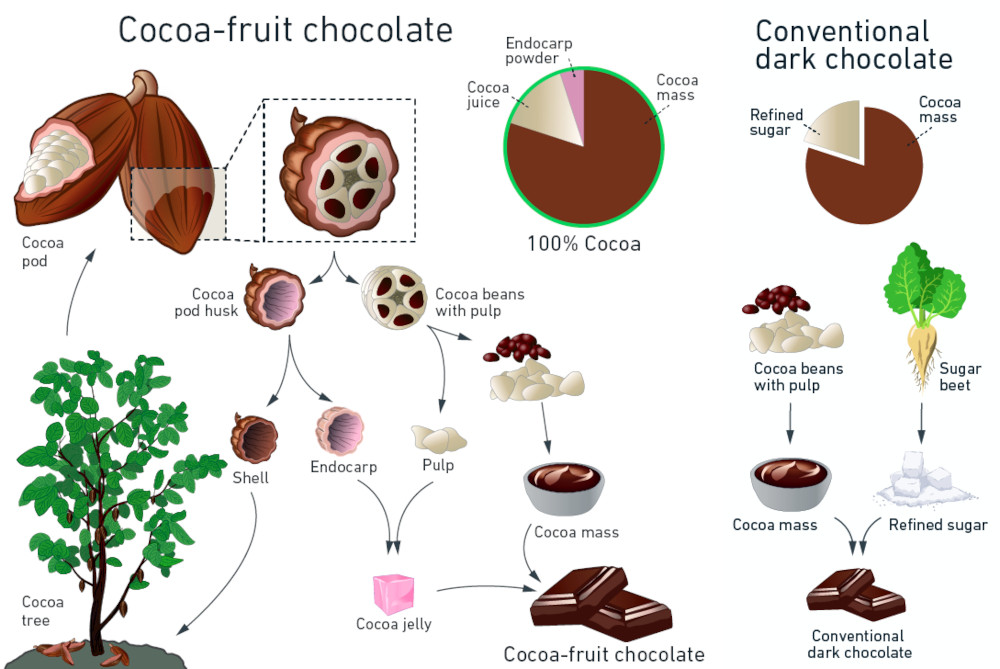Researchers at ETH Zurich — a public research university
in Zürich, Switzerland — have developed a type of chocolate that makes
use of an agricultural waste stream and is more sustainable and nutritious than
conventional varieties. The team has also joined forces with the chocolate
industry to investigate the potential for making maximum use of the cocoa fruit,
which would increase the profitability of cocoa cultivation while making
chocolate a healthier indulgence.
The main components of conventionally produced chocolate are cocoa mass
(beans) and cocoa butter, which are extracted from the cacao fruit.
But cacao fruit is a
superfood
that contains additional, valuable ingredients that have been largely
underutilized until now — in producing conventional chocolate, the industry
wastes 70 percent of the cacao
pod. And
while brands such as Barry
Callebaut
and Blue Stripes are exploring the many
potential uses for the rest of the fruit, efforts to make use of these
nutritious waste products have yet to scale.
So, as part of an Innosuisse
project, a research team led by emeritus ETH professor Erich
Windhab, worked together
with Koa — a Swiss-Ghanaian startup
that upcycles cacao fruit, especially the typically discarded pulp, into
value-added ingredients to improve the resilience of cocoa farms and reduce the
carbon footprint of the West African cocoa industry — and Swiss chocolate
manufacturer Felchlin to develop their own recipe
for cocoa-fruit chocolate.
 Image credit: ETH Zurich
Image credit: ETH Zurich
The ETH researchers used the flesh and parts of the cacao fruit shell (called
the endocarp) for their cocoa-fruit chocolate recipe — processing it into
powder and mixing it with part of the pulp to form cocoa gel. The resulting
sweet, gel substance can replace the added powdered sugar that is normally part
of the chocolate recipe.
However, landing on the perfect cocoa-fruit chocolate recipe was a challenge:
Too much fruit juice extracted from the pulp made for a clumpy chocolate (an
issue usually solved by adding powdered sugar), but too little resulted in an
insufficiently sweet product. In the end, the experiments showed that chocolate
may contain up to 20 percent gel, which equivalates to the sweetness of
chocolate with 5 to 10 percent powdered sugar — in comparison, conventional dark
chocolate can easily contain between 30 and 40 percent powdered sugar.
Healthier, more sustainable and more lucrative for farmers
According to Kim Mishra —
former postdoc researcher at ETH and main author of the Nature
Food study on the project — ETH’s
cocoa-fruit chocolate was then vetted by a panel of taste-testers from the Bern
University of Applied Sciences, with some containing
various amounts of powdered sugar and others containing the new variety
sweetened with cocoa gel: “This allowed us to empirically determine the
sweetness of our recipe as expressed in the equivalent amount of powdered
sugar,” he explains.
In addition to meeting expectations for flavor, by using cocoa gel as a
sweetener, cocoa-fruit chocolate boasts about 20 percent higher fiber content
than your average European dark chocolate (15 grams versus 12 grams per 100
grams) — which prevents blood sugar levels from rising too rapidly when
consuming chocolate — and only 23 grams of saturated fat, as opposed to the
usual 33 grams (a reduction of 30 percent).
Planting seeds for added value
The biggest opportunities here could be for smallholder cocoa
farmers
— the majority of whom struggle to earn a living
income
from their work. By scaling demand and processing capacity for more parts of the
cacao pod, farmers can eliminate waste, diversify their product
offerings
and increase their income. And if most of the fruit can be used to produce
cocoa-fruit chocolate, only the shell remains — which is traditionally used as
fuel or composting
material.
“This means that farmers can not only sell the beans, but also dry out the juice
from the pulp and the endocarp, grind it into powder and sell that, as well,”
Mishra says. “This would allow them to generate income from three value-creation
streams. And more value creation for the cocoa fruit makes it more sustainable.”
And while this could be a win on many fronts, ETH’s cocoa-fruit chocolate won’t
be hitting store shelves anytime soon.
“Although we've shown that our chocolate is attractive and has a comparable
sensory experience to normal chocolate, the entire value-creation chain will
need to be adapted — starting with the cocoa farmers, who will require drying
facilities,” Mishra says. “Cocoa-fruit chocolate can only be produced and sold
on a large scale by chocolate producers once enough powder is produced by
food-processing companies.”
The first step has been taken: ETH has filed a patent for its cocoa-fruit
chocolate recipe. The development of cocoa-fruit chocolate is a promising
example of how technology, nutrition, sustainability and income diversification
for small farmers can work in tandem to improve the entire value-creation chain
of one of our most popular commodities.
Get the latest insights, trends, and innovations to help position yourself at the forefront of sustainable business leadership—delivered straight to your inbox.
Sustainable Brands Staff
Published Jun 18, 2024 8am EDT / 5am PDT / 1pm BST / 2pm CEST